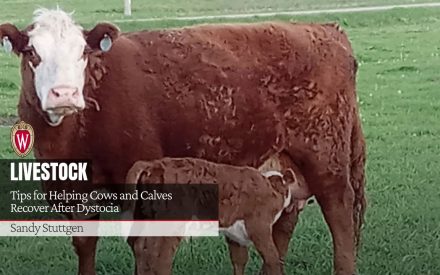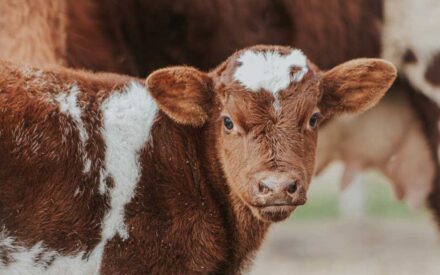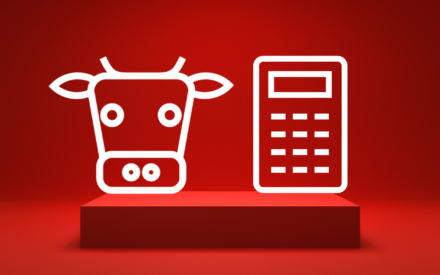During the dark and cold of winter, it can be uplifting to think about the new season just around the corner. Spring represents new growth and renewal. The same is true of calving season for our beef operations. While in practice our beef calving seasons vary greatly in timing from farm to farm, it’s always a good time to review your calving season preparation checklist.
Preparation for calving season starts months in advance by monitoring body condition scores, adjusting rations as gestational nutritional requirements increase, and working on your annual herd health plan and Vet Client Patient Relationship.
For now, we are focusing on the immediate prep before the first calf hits the ground, which includes knowing your AI breeding dates and/or beginning and ending dates females were exposed to a bull. Average gestation lengths range from 279-287 days but can go longer and shorter. Factoring in the possibility of a calf arriving a week or two early, plus the time to re-order supplies or repair facilities if needed, means your calving season preparations should start a minimum of 3-4 weeks in advance.
Checking calving areas and facilities includes making sure all gates, fences, chutes/head gates, and lighting are in working order. Areas may need cleaning and fresh bedding needs to be on hand to prevent disease transmission to newborn calves. Have an inclement weather plan for calving in cold or wet conditions. This may mean having calf coats and a calf warming box ready to go. If calving outdoors, plan to use extra bedding and ensure wind breaks are available.
There are several items to consider placing in your calving kit, and this is not an exhaustive list. A starting place is inspecting last year’s equipment. For example, if calf bottles and esophageal feeders have cracks, or were put away dirty last year, it’s time to toss and replace. Other items to consider include:
- Veterinarian’s phone number
- Disposable OB gloves
- OB lubricant
- OB chains or straps plus handles
- Calf puller
- Clean towels
- Halter and rope
- Disinfectant
- Water pail and access to warm water
Post calving items to include are:
- Ear tags and tagger
- Record keeping forms
- Frozen colostrum or a colostrum replacer
- Iodine or other navel disinfectant
- Needles and syringes
- Calf bottle
- Esophageal feeder
- Newborn calf vaccines and/or supplements
Cows don’t always calve at the time we would choose if we were in control, making for some long days and nights. You can encourage 80% of calvings to occur between 7 am and 7 pm by feeding close-up cattle twice daily at 11.30 am and 9.30 pm. Check at least three times during every 24-hour period to detect calvings as they begin. The goal is to assist difficult calvings, and to dip navels, ear tag, and check that calves have nursed and received colostrum within their first six hours of life. If you record birth weights, now is the time to do that as well. Think ahead about other work needs on and off the farm and how to make them less stressful during calving season.
People need to prepare too. Do you have warm barn clothes, waterproof boots, a flashlight, or better yet a hands-free headlamp, ready to go? Consider preparing freezer meals in advance to save time and ensure you are caring for yourself too. Have a safety plan for yourself around fresh cows. Cows can and will become aggressive protecting their newborn calf, even if they have a calm disposition the remainder of the year. Know your escape routes from pens. Use gating or portable cages to separate the mother from you and the calf for tagging and other calf processing tasks.
The article originally appeared in Wisconsin Agriculturist Magazine.
References:
Calving kit preparation for cow-calf producers. T. Salzer and J. Armstrong. University of Minnesota Extension. Reviewed in 2021. Accessed 9-09-2021 https://extension.umn.edu/beef-cow-calf/calving-kit-preparation-cow-calf-producers
Preparing for calving season. O. Amundson. South Dakota State Extension. Updated 2020. Accessed 9-09-2021 https://extension.sdstate.edu/preparing-calving-season
Preparing for a successful calving season: nutrition, management, and health programs. G. Lardy and C. Stoltenow. North Dakota State Extension publication AS1207. Revised 2017.
Managing for a Successful Calving Season. S. Stuttgen. Extension Livestock Topic hub
Reviewed by: Dr. Sandy Stuttgen, Extension Livestock Educator

 Ayudar las vacas y a los terneros a recuperarse después de una Distocia
Ayudar las vacas y a los terneros a recuperarse después de una Distocia Tips for Helping Cows and Calves Recover After Dystocia
Tips for Helping Cows and Calves Recover After Dystocia Calves born early in the calving season have more value
Calves born early in the calving season have more value Beef & Dairy Cattle Gestation and Calving Date Calculator
Beef & Dairy Cattle Gestation and Calving Date Calculator


